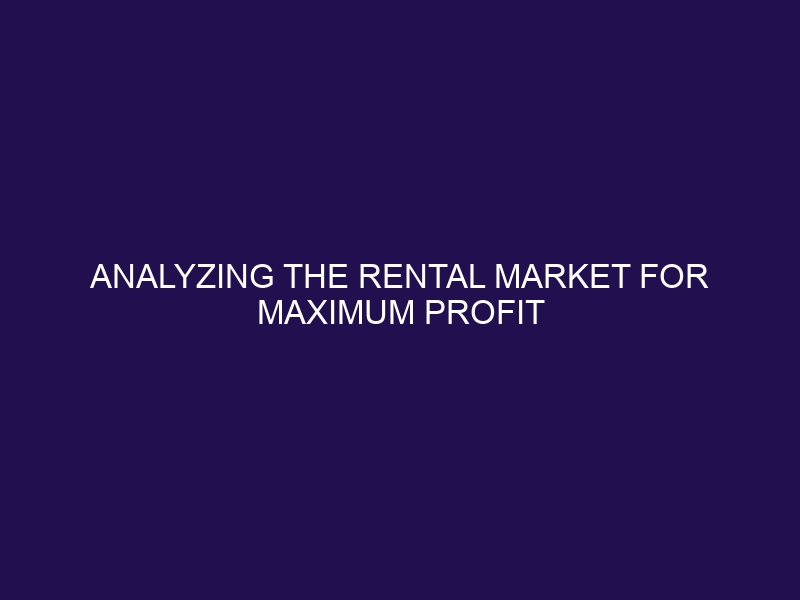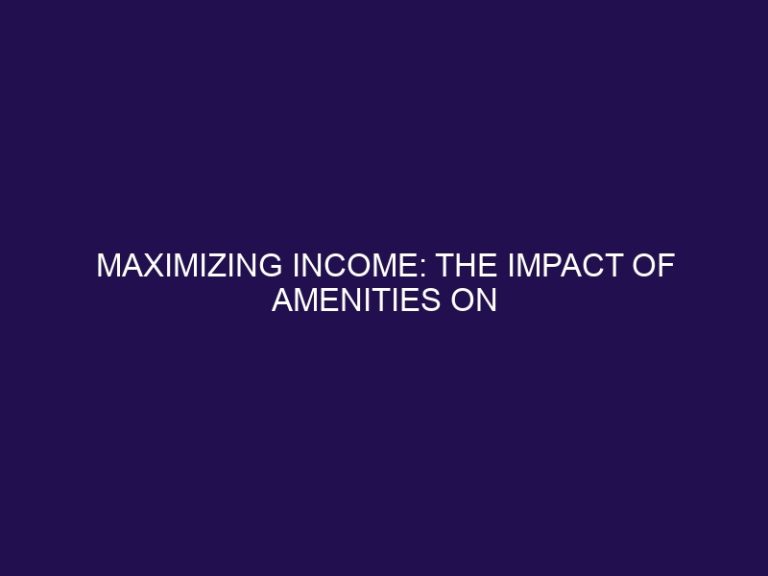Analyzing the Rental Market for Maximum Profit
The rental market is a competitive and ever-changing industry that offers a variety of opportunities for individuals and businesses looking to invest in rental properties. Understanding the rental market and its current state is crucial for making informed decisions and maximizing profits.
According to the National Association of Realtors, the rental vacancy rate in the United States was at 6.4% in the first quarter of 2021, a slight decrease from the previous year. This shows that the rental market is still in high demand, making it a lucrative investment option.
Several factors can affect the rental market, such as economic conditions, population growth, job opportunities, and interest rates. These factors can impact the supply and demand of rental properties, affecting rental prices and vacancy rates. It is essential to keep an eye on these factors to make informed decisions when investing in rental properties.
Identifying the best rental properties is crucial for maximizing profit in the rental market. A good rental investment property typically has a high potential for rental income, low vacancy rates, and appreciation in value. Properties in high demand areas, such as near universities, employment centers, and public transportation, are considered to be good rental investments. Additionally, features such as a safe and desirable neighborhood, low maintenance costs, and amenities like parking, laundry, and outdoor space can also make a property appealing to potential tenants.
To increase rental income, it is essential to keep the property in good condition and offer amenities that tenants value. Regular maintenance and upgrades can help attract and retain quality tenants, who are willing to pay higher rent for well-maintained properties. Cutting down on expenses, such as energy-efficient upgrades and proper budgeting, can also help increase profits in the long run.
Finding reliable tenants is crucial for maintaining a steady rental income and reducing the risk of property damage or missed payments. Conducting thorough background checks and screening potential tenants can help find responsible and trustworthy individuals. Additionally, offering incentives, such as a referral program or discounts for on-time rent payments, can also help attract and retain quality tenants.
Staying ahead of the competition in the rental market requires keeping up with the latest trends and offering unique and desirable features to tenants. Millennials, who make up a significant portion of the rental market, value convenience and technology, so incorporating smart home features and offering online rent payments can make a property more appealing to this demographic. It is also important to regularly review and adjust rental prices to stay competitive and attract potential tenants.
While the rental market can be a profitable investment, there are also potential risks involved, such as property damage, late payments, or vacancy rates. Conducting thorough research, having a solid lease agreement, and investing in landlord insurance can help mitigate these risks and protect your investment. Keeping up with market trends and being prepared for potential challenges can help ensure long-term success in the rental market.
Understanding the Rental Market
Understanding the Rental Market involves examining factors such as:
- supply and demand
- local regulations
- tenant preferences
What is the Current State of the Rental Market?
The current state of the rental market is reflective of high demand, with increasing rents and low vacancy rates in urban areas. Suburban and rural areas are also experiencing growth due to trends in remote work and lifestyle changes.
What Factors Affect the Rental Market?
Economic conditions, interest rates, housing supply and demand, population growth, and government policies are all key factors that can affect the rental market.
Identifying the Best Rental Properties
- Location: When looking for the best rental properties, it is important to consider areas with low vacancy rates and high demand, such as urban centers or locations near universities.
- Property Type: Evaluate single-family homes, condos, or multi-family units based on the local demand and rental trends in the area.
- Financial Analysis: It is crucial to assess the potential rental income, expenses, and return on investment for each property before making a decision.
- Condition: Before investing, it is essential to inspect properties for good maintenance, amenities, and potential for appreciation.
What Makes a Property a Good Rental Investment?
What Makes a Property a Good Rental Investment?
A good rental investment property should have high demand, positive cash flow, low vacancy rates, and potential for appreciation. Factors like location, amenities, and property condition contribute to its appeal to tenants and profitability.
What Types of Properties are in High Demand?
Properties in high demand include:
- urban apartments
- single-family homes
- vacation rentals near tourist attractions
This demand is driven by:
- population shifts
- lifestyle changes
- travel trends
Additionally, properties with modern amenities and sustainable features are increasingly sought after.
What are the Key Features to Look for in a Rental Property?
When searching for a rental property, it’s important to consider its location, amenities, safety, and potential for rent appreciation. Make sure it’s close to transportation, schools, and amenities, and includes desirable features such as in-unit laundry, parking, and security.
Additionally, assess the potential for future development and demand to make an informed investment decision.
Maximizing Profit in the Rental Market
- Researching rental market trends is crucial in order to set competitive prices and maximize profit.
- Enhancing property appeal through regular maintenance and modernization can also help attract potential tenants and increase profits.
- Offering incentives for long-term leases can secure steady income and ensure a stable cash flow.
- Implementing efficient marketing strategies is essential in reaching potential tenants and filling vacancies quickly.
- Monitoring expenses and seeking cost-effective solutions for property management can also contribute to maximizing profit in the rental market.
How Can You Increase Rental Income?
- Regular Rent Reviews: Continuously review and adjust rent to align with current market rates and any property improvements.
- Value-Adding Amenities: Provide extra services or amenities, like parking spaces, laundry facilities, or pet-friendly options, to justify higher rental prices.
- Property Upgrades: Elevate the appeal of the property by making renovations, modernizing, or implementing energy-efficient upgrades.
What Are the Most Effective Ways to Reduce Expenses?
To effectively reduce expenses in the rental market, it is important to consider:
- energy-efficient upgrades
- regular maintenance to prevent costly repairs
- bulk purchasing for supplies
Another effective method is implementing automated rent collection systems, which can save both time and money.
Additionally, conducting thorough tenant screenings can help avoid potential financial losses.
What Are the Best Strategies for Finding Reliable Tenants?
To ensure the best strategies for finding reliable tenants, it is important to utilize thorough background checks, including credit and rental history. Additionally, requesting references from previous landlords or employers can provide valuable insight. Implementing a clear and comprehensive rental application process is also crucial in assessing the tenant’s suitability. Lastly, maintaining open communication is key in addressing any concerns promptly.
Staying Competitive in the Rental Market
To remain competitive in the rental market, landlords should prioritize property maintenance, provide desirable amenities, and stay informed about local rental trends.
What Are the Latest Trends in the Rental Market?
In today’s rental market, there is a growing demand for eco-friendly and smart homes, co-living spaces, and short-term rentals due to the rise of the gig economy. Furthermore, virtual property tours and digital transactions have become commonplace, transforming the rental industry. Recently, I learned about a friend who incorporated smart home technology into their rental property, attracting tech-savvy tenants and boosting their rental income.
How Can You Stay Ahead of the Competition?
- Offer Unique Amenities: Give your properties an edge by providing exclusive features like smart home technology or eco-friendly upgrades.
- Enhance Property Appeal: Attract tenants by regularly maintaining your properties, keeping the landscaping well-maintained, and making aesthetic upgrades.
- Effective Marketing: Utilize social media, professional photography, and virtual tours to effectively showcase your properties to potential tenants.
- Stay Informed: Stay ahead of the competition by staying up-to-date on market trends, rental laws, and competitor offerings in order to make informed decisions.
In the competitive rental market of the 1990s, property owners gained an advantage by offering high-speed internet access as a unique amenity, setting new standards for property appeal and tenant satisfaction.
What Are the Potential Risks and How Can You Mitigate Them?
To mitigate the potential risks in the rental market, it is important to conduct thorough background checks on potential tenants, maintain emergency funds for property repairs, and consider obtaining landlord insurance to safeguard against unforeseen events.
Frequently Asked Questions
What is rental property analysis and why is it important for real estate investors?
Rental property analysis is the process of evaluating an investment property to determine its viability and projected profitability as a rental property. It is important for real estate investors because it helps them make informed decisions and avoid potential risks, ultimately leading to a profitable investment.
What are the essential factors to consider in a rental property analysis?
There are 9 essential factors to consider, including location, rental strategy, expenses, cash flow, cap rate, cash on cash return, occupancy rate, market analysis, and property condition. Each of these factors plays a crucial role in the success and profitability of a rental property.
How can rental property analysis tools help in optimizing profitability?
Rental property analysis tools, such as those offered by Mashvisor, provide real estate investors with market level data, accurate rental rates, and expert housing market predictions. By utilizing these tools, investors can make informed decisions and generate enough profit from their rental investments.
What are the six steps to conducting an accurate rental market analysis?
The six steps are: 1) determining the type of rental (long-term or short-term), 2) researching the market and rental demand, 3) analyzing property prices and expenses, 4) projecting potential rental income, 5) optimizing occupancy and marketing strategy, and 6) reviewing and updating the analysis regularly. Mashvisor’s rental property analysis tools can assist in each step, making the process easier and more accurate.
Is it necessary to work with a real estate agent or property manager for rental property analysis?
While it is not a requirement, it is highly recommended to work with an experienced real estate agent or property manager who has knowledge and expertise in rental property analysis. They can provide valuable insights and help make or break the success of a rental investment.
What are the expected returns on investment for traditional rental properties and Airbnb rental properties?
The expected return on investment for traditional rental properties is typically lower, with a focus on steady, long-term income. On the other hand, Airbnb rental properties have the potential for higher returns but may require more effort and management. It is important to choose the right rental strategy for each specific property to maximize profits.







